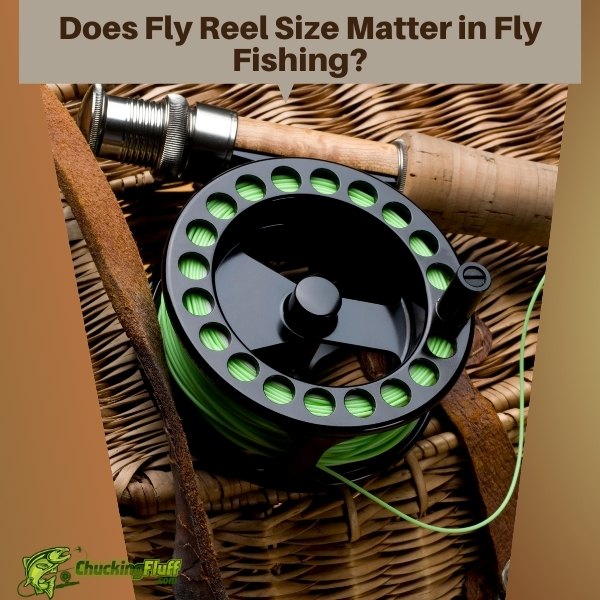| Disclosure: Just to be open and honest the buttons and links you click on in the website will in most cases take you to another website where you can purchase the products I am reviewing. As an Amazon Associate I earn from qualifying purchases. |
Does Fly Reel Size Matter in Fly Fishing? Importance of Reel Size

Fly fishing is not just about casting technique and fly selection; your fly fishing gear and apparatus play a vital role in your success.
Among your essential tools, the fly fishing reel is a critical component.
But does fly reel size really matter?
Let’s explore this question in detail.
Quick Post Navigation
Line Capacity: The Importance of Spool Size
The size of your fly reel affects its fly line capacity, which then determines how much fishing line and backing it can hold.
This simple aspect of fly reel size can have an impact on your fly fishing experience, for instance;
Different fishing scenarios require various amounts of line.
A larger reel can accommodate more fly line and backing, allowing you to target larger fish or fish in deeper waters.
For instance, when you’re going after that elusive trophy fish in a deep lake, having ample line capacity on your reel can make a huge difference.
You won’t have to worry about running out of line when your catch decides to make a long, powerful run.
On the other hand, if you’re trout fishing in a small, shallow stream, you may not need a massive line capacity.
In such scenarios, a smaller reel can be more convenient, reducing unnecessary bulk and weight in your gear allowing you to fish for longer and not get fatigued.
Balance and Feel: Finding Harmony
The size of your fly reel also impacts the overall balance and feel of your fly fishing setup.
Picture this: you’re out on the river, casting for hours on end.
With the right balance, your casting accuracy improves, and you experience less fatigue during those long days on the water.
Choosing the right reel size ensures harmony between your rod, reel, and line weight.
A well-balanced outfit allows you to cast with precision and control, making your fly presentation more accurate.
When everything feels right in your hands, your chances of success increase.
Retrieval Rate: The Need for Speed
Another critical factor influenced by the diameter of the fly reel is the rate at which line is retrieved with each turn of the handle.
A larger reel typically retrieves more line per revolution, making it easier to bring in fish quickly when needed.
This increased retrieval rate can be crucial when dealing with fast-swimming or aggressive fish.
Imagine you’re fly fishing for salmon, and one of these powerful creatures takes your fly and dashes upstream.
In this situation, a larger reel can help you keep up with the fish and regain control.
Conversely, a smaller reel may struggle to retrieve line quickly enough, increasing the risk of losing the fish.
Functionality in Specific Situations: One Size Doesn’t Fit All
Consider your fishing environment and target species.
In saltwater fly fishing, for instance, larger reels are preferred due to the size and strength of saltwater species like Tarpon.
These fish can put up a fierce fight, often requiring more line capacity and a robust drag system to handle their power.
A larger reel ensures you’re prepared for the challenges of saltwater angling.
Conversely, smaller reels are suitable for freshwater trout fishing, where line capacity and retrieval rate may be less critical.
In these serene settings, you can enjoy the delicacy and finesse of fly fishing without the need for heavy-duty gear.
Fly Line Weight Compatibility: Matching the Pieces
While it’s essential to consider the size of your fly reel, it’s equally crucial to ensure that it matches the weight of your fly line.
A reel that is too small for the line can lead to decreased performance and difficulties in managing larger fish.
The weight of your fly line and the weight rating of your reel should complement each other.
An imbalanced setup can result in casting problems, reduced accuracy, and an overall frustrating fishing experience.
Be sure to consult manufacturer recommendations and experts in the field to make sure your reel and line are a perfect match.
Conclusion: Size Matters in Fly Fishing Reels
So, does fly reel size matter in fly fishing?
Yes, it does.
The size of your fly reel affects line capacity, balance, retrieval rate, and functionality in specific fishing scenarios.
To maximize your angling success, carefully consider the size of your fly reel in relation to your fishing style, target species, and line weight.
Remember that selecting the right reel size is a crucial decision that can greatly enhance your fly fishing experience.
It’s not just about catching fish; it’s about enjoying every moment you spend on the water.
Happy fly fishing! Whether you’re chasing trout in mountain streams or battling marlin in the open ocean, may your reel size always be in perfect harmony with your angling aspirations.
Remember that selecting the right reel size is a crucial decision that can greatly enhance your fly fishing experience.
It’s not just about catching fish; it’s about enjoying every moment you spend on the water.


